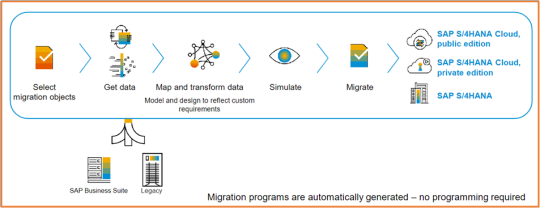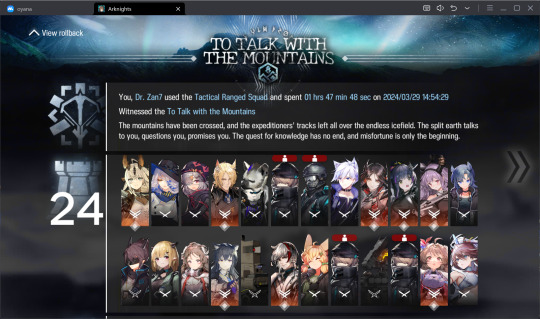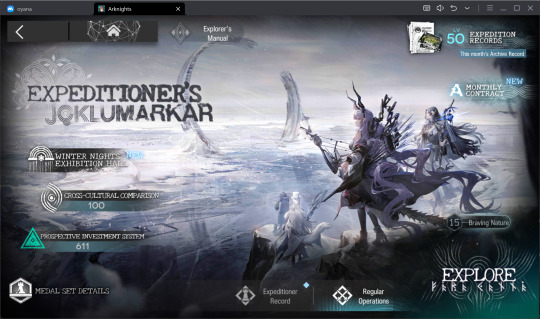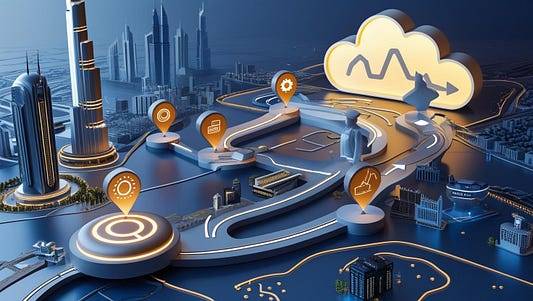#Migration Strategy
Explore tagged Tumblr posts
Text
#migrants#poland#finland#migration strategy#polish prime minister donald tusk#temporary suspension of migrants' right to asylum#asylum seekers
2 notes
·
View notes
Text
SAP Migration Cockpit and Migration Strategy
Since the Migration Cockpit is delivered with the S/4HANA system and replaces the Legacy System Migration Workbench (SAP LSMW), our article will explain this tool in detail. Alternative solutions will be briefly addressed. Factors influencing the choice of migration strategy and tool include the number and volume of migration data objects to be transferred and converted, acceptable system downtime, data quality in source systems, required data changes or optimizations, the deployment model of the target system (SAP cloud or SAP on-premise system), and the number and type of source systems. Learn more about the Migration Cockpit and Migration Strategy, if required via our translator:
https://s4-experts.com/2023/11/29/sap-s-4hana-datenmigration-und-das-migrationscockpit/
#SAP #migration #Strategy #migrationcockpit

0 notes
Text
Accelerate Digital Transformation with On Premises Cloud Migration | Applify
On-Premises infrastructure to secure, scalable cloud environments. Our On Premises Cloud Migration services include strategic planning, workload assessment, cloud architecture design, and seamless execution—ensuring minimal downtime and maximum performance. Whether you're migrating to AWS, Azure, or Google Cloud, we ensure a future-ready transformation with optimized costs, improved agility, and enhanced security.
#On Premises To Cloud#Cloud Migration#Legacy To Cloud#Cloud Transition#Cloud Modernization#Migration Strategy#Cloud Adoption
0 notes
Text
Migration Strategy and Best practices

Data migration is the process of moving data between the two systems. It is a key consideration for any system implementation, upgrade, or consolidation.
Organizations undergo data migrations for several reasons. They might need to adopt to enhance/create the digital experiences in the entire system, upgrade databases, establish a new data warehouse, or merge new data from an acquisition or other source. Data migration is also necessary when deploying another system that sits alongside existing applications. Data migration is categorized as
● Storage migration
● Database migration
● Application migration
● Business process migration
Data migrations are seldom as pleasant as a spring walk in the park, but by following these best practices, your task should be easier.
Although migrations are usually divided into “extract, transfer, and load,” a better approach might be:
● Ideate
● Plan
● Prepare
● Extract, Validate
● Transfer, Validate
● Load, Validate
● Audit
● Test
In the context of the extract-transform-load (ETL) process, any data migration will involve at least the transform and load steps. This means that extracted data needs to go through a series of functions in preparation, after which it can be loaded into a target location.
Strategy for successful Data Migration Less successful migrations can result in inaccurate data that contains redundancies and unknowns. Any issues that did exist in the source data can be amplified when it’s brought into a new, more sophisticated system. A complete data migration strategy prevents a subpar experience that ends up creating more problems than it solves. Aside from missing deadlines and exceeding budgets, incomplete plans can cause migration projects to fail altogether. In planning and strategizing the work, teams need to give migrations their full attention, rather than making them subordinate to another project with a large scope. A strategic data migration plan should include consideration of these critical factors:
● Mapping the data: – Before starting the ETL we need to map the attributes from the source to the target to validate the whole business functionality from the legacy to the target system. Unexpected issues can surface if this step is ignored
● Cleanup: while in the process of preparation/extraction any kind of data issues/ functional dependencies with your source data must be resolved
● Code Merge: The baseline code of the latest target version needs to be taken from any fresh installation of the target version/patch. Merge the customized policy opcodes & custom facility module codes to the baseline code to create the target deployment package.
● Maintenance and protection: Categorize the data which is required to be maintained into the target system and which is required to be maintained as an archive in the tapes/disks, define as much as cleaner data in the target system
● Governance: Tracking and reporting on data quality is important because it enables a better understanding of data integrity. The processes and tools used to produce this information should be highly usable and automate functions where possible. In addition to a structured, step-by-step procedure, a data migration plan should include a process for bringing on the right tools for the project.
Data Migration approaches There is more than one way to build a data migration strategy. Based on the organization’s specific business needs and requirements will help to establish the most appropriate way. However, most strategies fall into one of two categories:
● Single-shot - big bang
● Incremental
“Single-shot” Migration In a big bang data migration, the full data transfer should be completed within a limited window of time. Because of this approach the Live systems experience downtime while data goes through ETL processing and transitions to the target database. The Pros
● Low Cost: that we can reduce the resource cost and infrastructure cost OPEX are lower than incremental rollout.
● Faster ROI
The Cons
● Of course, that it all happens in one time-boxed event, requiring relatively little time to complete
● The pressure, though, can be intense, as the business operates with one of its resources offline
This risks compromised implementation. Based upon the business needs this approach will be followed and planned multiple dress rehearsals to make sure the data migration is bounded to the time limits and finding out the data quality before the actual go-live event for the new systems.
Incremental/Phased” Migration Incremental/Phased migrations, in contrast, complete the migration process in increments/phases. In this approach, the old system and the new are run in parallel, which eliminates downtime or operational interruptions. Processes running in real-time can keep data continuously migrating. The Pros
● There are no hard and fast deadlines for the new system live event. As both the existing and new systems runs parallel
● The Organization will have more time to adopt the new system and get used to it
The Cons The cost of the resources and infrastructure will be more and also the OPEX is also more as until the new system stability confirms, the organizations have to maintain both applications in the entire ecosystem. Best Practices for Data Migration irrespective of the approach followed. Regardless of which implementation method you follow, there are some best practices to keep in mind:
● Backup the data always
● Stick to the strategy and follow the plan, not to change the strategies in between the implementations
● Audit the data in the process of ETL, as there may be the chances of data loss/mismatch as both the legacy and the target are always not the same as we think
● Test, test, test: During the planning and design phases, and throughout implementation and maintenance, test the data migration to make sure you will eventually achieve the desired outcome
● Conduct multiple iterations of ETL in the implementation phase with the live data. and validate the live test with business functionality
● Define the process/approach immediate post-migration before switching on it to handle life
To know more visit: Covalensedigital
To Contact Us: Covalensedigital Solutions
0 notes
Text
#Australia#migrant intake#tougher tests#Indian students#population increase#Australian Bureau of Statistics#migration strategy#English-language test#genuine students#skills shortages#overseas students#second course#second student visa#immigration policy#Pramod Thomas#Clare O’Neil#home affairs minister#Parliament House#Canberra#jobs and skills summit#Martin Ollman#Getty Images#immigration news#Australian government#international students#student visa#English proficiency#skills assessment#immigration reforms#Australian demographics
0 notes
Text
IS4 BN15 Ending 1 done with no progression tree. This certainly isn't the hardest thing I've done, but it is probably is the most stupid.





#arknights#is4#integrated strategies#afaik only 1 person (on CN) has done this so i believe i'm the 2nd person to have done this :D#shoutouts to my oomfie the surprise foldartal#probably about on par with the migrate foldartal that shit is so incredibly fucking busted
18 notes
·
View notes
Text
Top 5 data management mistakes costing UAE businesses millions
Introduction
In an increasingly digital economy, poor data practices have become more than just an IT issue—they are an enterprise-level risk.

Across the UAE, businesses are losing millions annually due to fragmented systems, inconsistent governance, and reactive strategies.
In this article, we’ll unpack five critical data managementmistakes, their tangible costs, and what forward-thinking firms are doing to stay compliant, competitive, and data-resilient in 2025.
1. Fragmented Data Silos Across Departments
While decentralization may speed up local decision-making, it often comes at the cost of data cohesion. Sales, marketing, finance, and operations frequently maintain isolated datasets that never sync—each with its own metrics, definitions, and reporting cycles. The cost? Missed opportunities, duplicated efforts, inconsistent KPIs, and customer insights that are either delayed or distorted due to incompatible sources. Fix: Implement centralized data lakes or unified ERP/CRM systems to bridge these silos. Introduce cross-departmental governance protocols, and enforce scheduled data synchronization to maintain consistency across all business functions.
2. Weak Data Governance and Access Controls
Many UAE businesses still lack formal governance policies. There’s little clarity on who owns the data, who can access it, and how data quality is maintained across systems and touchpoints. The cost? Increased risk of data breaches, GDPR/DIFC non-compliance, unauthorized exposure of sensitive information, and eroded stakeholder trust—especially in sectors like healthcare, finance, and public services. Fix: Deploy a robust data governance framework with clearly defined roles, role-based access controls, automated audit trails, and regular compliance reviews. Embed accountability at every stage of data creation and usage.
3. Overreliance on Legacy Infrastructure
Outdated database architectures, manual Excel trackers, and siloed on-prem systems continue to dominate back-end processes—despite widespread digital front-ends. The cost? Performance bottlenecks during scale, limited real-time data visibility, high IT maintenance overheads, and an inability to integrate with modern analytics or automation tools. Fix: Migrate to cloud-native platforms that support elastic scaling, system redundancy, and embedded analytics. Incorporate APIs for seamless integration with existing digital tools while phasing out legacy dependencies.
4. Lack of Data Quality Assurance
Inconsistent formats, missing fields, outdated records, and duplicated entries remain common issues across enterprise datasets—especially when multiple input sources aren’t standardized.
The cost?
Flawed business reports, poor AI/ML model performance, customer experience setbacks, and incorrect decision-making based on unreliable data.
Fix:
Introduce end-to-end data quality frameworks that include automated validation checks, enrichment protocols, and AI-driven anomaly detection.
Regular audits and cleansing routines should be part of standard operations.
5. Treating Data Strategy as a One-Off Project
Many businesses initiate data initiatives as one-time efforts—an implementation followed by months (or years) of stagnation.
Without ongoing refinement, systems become outdated, and processes lose alignment with evolving business needs.
The cost?
Strategic misalignment, increasing technical debt, and declining ROI on digital investments that fail to evolve with the organization’s goals.
Fix:
Create a living data strategy—an adaptive roadmap reviewed quarterly, driven by key stakeholders across departments.
Tie progress to measurable KPIs like operational efficiency, customer satisfaction, or revenue growth from data-led initiatives.
Turn Costly Data Chaos into Smart Business Decisions: Nordstar Vision
At Nordstar Vision, we help businesses move from fragmented systems to future-ready data ecosystems.
Whether you’re struggling with outdated infrastructure, data silos, or lack of governance, our team brings tailored solutions to help you scale confidently in a data-first economy.
Let’s turn your data into a growth engine.
Reach out to us today at +(971) 50 1108756 or visit nordstartvision.
#data management UAE#business data mistakes#UAE data strategy#data governance UAE#database management Dubai#digital transformation UAE#legacy system issues#cloud migration UAE#data silos#enterprise data solutions#data compliance UAE#Nordstar Vision#data quality assurance#CRM data issues#ERP data integration#UAE business IT risks#data-driven decisions#business analytics UAE#smart data practices
2 notes
·
View notes
Text
Door-to-Door Campaigning: Engaging White Women for Kamala Harris
Door-to-Door Campaigning for Kamala Harris Armed with a clipboard and an array of campaign literature, Liz Minnella ventured into the neighborhoods of New Hope, Pennsylvania, fueled by a hopeful spirit that by day’s end, the town would indeed fulfill its optimistic name for Vice President Kamala Harris’s campaign. As she walked along the tree-lined streets, the absence of political yard signs…
#2024 election#Democratic activism#Donald Trump#door-to-door campaigning#election strategy#Kamala Harris#migration concerns#Pennsylvania#reproductive rights#voter engagement#white women voters
1 note
·
View note
Text
The Sigzen Advantage: Innovating Infrastructure Upgrades and Migration Solutions
Sigzen Technologies, a trailblazer in infrastructure upgrades and migration solutions, stands at the forefront of technological innovation. With a rich history steeped in delivering excellence, Sigzen has solidified its reputation as a leading service provider, catering to diverse business needs worldwide.Sigzen prides itself on a comprehensive suite of expertise centered on infrastructure…

View On WordPress
#Digital Transformation Strategies#igzen Tech Revolution#Infrastructure Upgrades#Innovate Your Systems#Innovation Insights#Mastering Infrastructure#Migration Solutions#Smart Systems Upgrade#Tech Evolution Guide#Tech Mastery Tips#Tech Transformation#Upgrade Your Infrastructure
2 notes
·
View notes
Text
Best Practices for Secure Data Migration to the Cloud
Migrating to the cloud isn’t just a technical upgrade, it’s a critical shift in how your organization handles, stores, and secures its most valuable data. While the benefits of cloud adoption are clear-scalability, flexibility, and reduced infrastructure costs-those advantages can be quickly undermined by poor security planning during migration.
Essential best practices for securing your data migration, ensuring a smooth and safe journey to the cloud.
1. Assess Your Existing Data
2. Encrypt Data During the Migration
3. Select a Reliable Cloud Provider
4. Implement Strict Access Controls
5. Back Up Your Data
6. Continuously Test Your Security
7. Ensure Compliance with Regulations
8. Post-Migration Security Measures
Securely migrating data to the cloud isn’t just about moving files, it’s about safeguarding your organization’s digital future. By following these best practices, from data classification and encryption to provider selection, access control, and post-migration vigilance, you can confidently embrace cloud adoption without compromising on security.
Read the Full Blog here@ https://teleglobals.com/blog/how-to-ensure-secure-data-migration-to-the-cloud
Cloud migration can be a transformative journey. With careful planning and strong security measures, your business can fully realize the benefits of the cloud while keeping sensitive data protected at every step.
#Cloud Migration#Data Security#Cloud Adoption#Teleglobal International#Secure Cloud#Digital Transformation#IT Strategy
0 notes
Text
Zohran Mamdani Radical Housing Plan Triggers Panic Across New York Real Estate Investors

Key Takeaways Zohran Mamdani’s rent freeze and communal housing proposals threaten to destabilize New York City’s property market, pressuring cash flow and cap rates. Billionaires and developers are consolidating millions behind Eric Adams to block Mamdani’s rise, while younger wealthy donors fuel his campaign. Federal tensions and investor flight risks are adding volatility, pushing capital toward more predictable markets until the election outcome is clear. Zohran Mamdani’s Housing Plan Could Shatter Investor Confidence Overnight Rent freezes. Tax hikes. Communal housing replacing luxury condos. Could this election destroy your cash flow and crush New York property values? Here’s what you’ll discover: Why billionaire developers are pouring millions into stopping Mamdani. How his rent freeze plan could wreck net operating income and cap rates. What federal tensions and investor flight could mean for your portfolio. Investors need to see this before November. Investors Brace for Rent Freezes, Tax Hikes, and Communal Living Proposals The shockwaves from Zohran Mamdani’s primary victory are rattling every corner of New York City’s property market. The 33-year-old socialist mayoral nominee is pledging to freeze rent, tax the wealthiest residents, and replace luxury condos with communal housing, a trifecta of policies that has developers, landlords, and investors bracing for impact. Real estate moguls, from SL Green’s Marc Holliday to billionaire John Catsimatidis, are mobilizing millions behind Mayor Eric Adams in a desperate attempt to halt Mamdani’s rise. Yet younger wealthy backers, dubbed the “Mamdani Millionaires,” are pouring money into his campaign, setting the stage for a high-stakes political showdown that could redefine property ownership and cash flow in the nation’s largest rental market. Socialist Victory Sparks Wall Street and Real Estate Panic Zohran Mamdani’s unexpected Democratic primary win has ignited alarm among New York City’s real estate elite. The candidate’s pledge to freeze rents and impose steep new taxes on high earners threatens to derail billions in projected property revenue across the city. Developers and investors, who count on predictable cash flow and market-driven rental adjustments, now face the possibility of government-controlled pricing and diminished net operating income. In response, top executives are rallying behind Mayor Eric Adams. SL Green’s Marc Holliday is spearheading rooftop fundraisers at One Madison Avenue, with entry tickets starting at $2,000 per person. Meanwhile, billionaire John Catsimatidis and other power brokers are hosting Hamptons events, aiming to build a financial firewall strong enough to stop Mamdani before November. Rent Freeze Threat Sends Shockwaves Through Property Owners Mamdani’s vow to impose a citywide rent freeze has property owners and investors on edge. While rent-stabilized landlords have faced temporary freezes in the past, notably under former Mayor Bill de Blasio, Mamdani’s plan signals a longer-term, ideologically driven shift that could cripple cash flow and erode asset valuations. By appointing Rent Guidelines Board members who refuse to approve increases, Mamdani could achieve a de facto freeze without new legislation. Landlord groups argue such tactics skirt the law and jeopardize both property maintenance and investor confidence. Analysts warn that prolonged rent stagnation would slash net operating income, push cap rates higher, and reduce the appeal of long-term buy-and-hold strategies in New York’s rental market. Communal Housing and State Grocery Stores: Investors Fear Economic Freefall Mamdani’s housing blueprint extends beyond rent freezes. His campaign speeches outline plans to convert luxury condominiums into communal living spaces with shared kitchens, laundry areas, and food co-ops. Combined with his proposal for city-run grocery stores and tax-funded childcare, these initiatives have developers warning of a market collapse.
Economists caution that policies of this scale could accelerate middle-class flight, shrink the city’s tax base, and trigger a ripple effect across property values. Landlords holding high-end units face the possibility of mandatory conversions, while institutional investors fear steep write-downs on luxury developments. Many analysts are already advising clients to delay acquisitions or restructure portfolios until the election outcome is clear. Billionaires Mobilize as Fundraising War Intensifies New York City’s wealthiest investors and developers are waging a financial counteroffensive to block Mamdani’s agenda. Power brokers, including John and Margo Catsimatidis, Kenneth and Maria Fishel, and real estate investor Jared Epstein, have hosted private Hamptons dinners and exclusive fundraisers, funneling millions toward Mayor Eric Adams. These events, many with $2,000 entry fees and curated guest lists, mark a coordinated effort to consolidate capital against Mamdani. Luxury brokers like Noble Black predict a series of high-profile gatherings through the fall as developers seek to safeguard property valuations, preserve favorable cap rates, and avoid the cash flow shocks that Mamdani’s policies could trigger. Business Leaders Sound Alarm Over Capital Flight Warnings from financial leaders are amplifying investor anxiety. Economist Stephen Moore has cautioned that Mamdani’s policies could spark an economic freefall, driving wealthy residents and corporations out of New York and shrinking the city’s tax base. Kevin O’Leary, the investor and media personality, says his offers to meet with Mamdani have been ignored — a signal he interprets as a rejection of private capital’s role in job creation and development. O’Leary has warned that if Mamdani’s policies move forward, institutional investors may divert funds to cities with friendlier tax structures and fewer regulatory risks. Developers are already pausing or canceling projects as November’s election looms. Fears of State-Controlled Property Ignite Historical Comparisons Critics argue that Mamdani’s housing agenda mirrors failed experiments from authoritarian regimes. His proposals, from government-run grocery stores to potential abolition of private property for housing guarantees, have drawn comparisons to mid-20th-century communist policies in China and Cuba. Opponents point to the poor quality and high vacancy rates of existing public housing as evidence that government-controlled systems often collapse under their own inefficiencies. For investors, the threat of forced conversions and state interference raises concerns about asset security, property valuations, and the long-term viability of New York’s private housing market. Trump Threatens Arrest Amid Federal-Local Showdown President Donald Trump has escalated tensions by suggesting Zohran Mamdani could be arrested if he continues to defy federal immigration enforcement. Speaking at a migrant detention facility in Florida, Trump labeled Mamdani a “communist,” signaling that federal-state conflict could deepen if Mamdani becomes mayor. For investors, the political standoff adds another layer of volatility. Federal intervention could disrupt city operations, delay approvals for development projects, and erode confidence among institutional buyers considering long-term commitments in New York City. Many analysts view the clash as a red flag for those reliant on stable regulatory environments. Assessment Zohran Mamdani’s rise is forcing investors to confront a reality where rent freezes, steep tax hikes, and state-controlled housing could reshape New York City’s property market. Cash flow models, cap rates, and long-term buy-and-hold strategies face mounting uncertainty as developers and landlords weigh whether to hold, sell, or reposition assets. For those willing to endure volatility, distressed acquisitions and opportunistic deals could surface if market values decline sharply. Yet for many, the risks,
from declining net operating income to escalating regulatory burdens, are pushing capital toward more predictable markets. Until November’s election resolves the city’s direction, investors are being advised to tighten risk assessments, reevaluate exposure, and prepare for a market that could shift overnight.
#billionaire donors#buy and hold#cap rates#capital flight#cash flow risk#communal housing#developer fundraising#distressed opportunities#economic freefall#election stakes#Eric Adams#federal conflict#housing crisis#institutional investors#investor panic#landlord concerns#market volatility#New York#policy uncertainty#portfolio strategy#property owners#rent freeze#rental market pressure#tax hikes#wealth migration#Zohran Mamdani
0 notes
Text
#united nations high commissioner for refugees#unhcr#migration strategy#migration#migrant return hubs#great britain#united kingdom#new eu pact on migration and asylum#migrants#refugees#asylum seekers
1 note
·
View note
Text
Why Azure Cloud Migration Is Essential for Modernizing Your IT Environment

In today’s hyper-connected, data-driven world, traditional IT systems are quickly becoming outdated. On-premises infrastructure, once the backbone of enterprise operations, now struggles to keep up with the growing demands of scalability, performance, agility, and cost-efficiency. As digital transformation becomes a business imperative, organizations are increasingly turning to cloud computing to modernize their IT environments, and Microsoft Azure stands out as a top choice.
Azure cloud migration offers businesses the tools, flexibility, and scalability they need to stay competitive and future-proof their operations. This article explores why migrating to Microsoft Azure is essential for modernizing your IT environment and how it sets the stage for long-term success.
The Problem with Legacy IT Infrastructure
Before diving into the benefits of Azure, let’s understand why legacy IT systems are holding businesses back:
High maintenance costs: On-prem servers require constant upkeep, including hardware upgrades, patching, and security updates.
Limited scalability: Scaling up typically involves purchasing more hardware, which takes time and capital investment.
Slower innovation: Rigid systems make it difficult to adopt new technologies like AI, machine learning, or IoT.
Security vulnerabilities: Older systems often lack modern threat detection and data protection capabilities.
Inadequate disaster recovery: Many businesses struggle with backup and recovery, risking data loss in the event of failure.
Azure provides a more adaptable, affordable, and scalable IT infrastructure that modern enterprises require.
What Is Azure Cloud Migration?
Azure cloud migration is the process of moving your organization’s digital assets—such as data, applications, servers, and workloads—from on-premises systems or other clouds to the Microsoft Azure platform. Azure provides a range of cloud services, including Infrastructure as a Service (IaaS), Platform as a Service (PaaS), and Software as a Service (SaaS), enabling you to run your business more efficiently.
Azure migration can be full (all assets) or hybrid (a mix of cloud and on-prem), depending on your business needs.
Why Azure? A Platform Built for Modernization
Microsoft Azure is more than just cloud storage—it’s a comprehensive platform designed to modernize and transform your IT infrastructure. Here's what makes Azure stand out:
Global Reach: Operates across 60+ regions with data centers worldwide.
Enterprise-Ready: Trusted by 95% of Fortune 500 companies.
Security & Compliance: Offers more than 100 compliance certifications.
Built-In Tools: Includes Azure Migrate, Cost Management, Security Center, and more.
Seamless Integration: Works effortlessly with Microsoft products like Office 365 migration, Windows Server, and Active Directory.
Let’s explore the specific benefits that make Azure cloud migration essential for IT modernization.
1. Scalability Without Limits
Modern businesses face unpredictable growth, seasonal spikes, and fluctuating workloads. You may scale resources up or down in real time with Azure's on-demand scaling.
Launch new apps quickly
Expand globally with minimal setup
Handle traffic surges without performance issues
No more over-provisioning hardware or dealing with capacity constraints—Azure grows with your business.
2. Improved Cost Efficiency
Running your data center is expensive. Azure migration drastically reduces capital expenditures (CapEx) by shifting to an operational expense (OpEx) model.
Pay only for what you use (pay-as-you-go)
Leverage Azure Reserved Instances for predictable workloads and savings
Reduce electricity, cooling, and physical space costs
Azure’s Cost Management + Billing tool also gives you complete visibility and control over your spending.
3. Enhanced Security and Compliance
Security is a top concern when modernizing IT. Azure is built with a multi-layered security model and has one of the broadest portfolios of compliance offerings.
24/7 threat monitoring and detection
Identity and access management via Azure Active Directory
Data encryption at rest and in transit
Support for GDPR, HIPAA, ISO 27001, and more
With Azure, you modernize your IT environment without compromising on security.
4. Accelerated Innovation with AI, ML, and Analytics
Modernization isn’t just about efficiency—it’s about enabling innovation. Azure makes it easy to integrate advanced technologies into your workflows:
Azure AI and Machine Learning tools to enhance decision-making
Power BI for real-time business intelligence and reporting
Azure Synapse Analytics for big data solutions
IoT Hub to connect and manage smart devices
With these tools, businesses can modernize not just infrastructure but also processes and customer experiences.
5. Improved Performance and Reliability
Azure's load balancing and global content delivery network (CDN) capabilities guarantee increased uptime and quicker performance for apps and services.
Azure's worldwide data centers allow apps to run closer to users.
Azure Traffic Manager and Load Balancer prevent slowdowns
99.95% availability with Service Level Agreements (SLAs)
Legacy infrastructure can’t match the performance and resilience that Azure offers out of the box.
6. Streamlined Backup and Disaster Recovery
Outdated systems are often vulnerable to data loss. Azure provides robust backup and disaster recovery (DR) capabilities.
Azure Backup automatically protects your data
Azure Site Recovery enables fast failover during outages
Customizable RTO and RPO options to meet business needs
With Azure, your IT environment is not just modern—it’s resilient.
7. Faster Deployment and Time-to-Market
Azure’s automation tools, templates, and DevOps services help organizations deploy applications faster and bring products to market in record time.
For continuous integration and deployment (CI/CD), use Azure DevOps.
Create infrastructure with ARM templates
Spin up VMs and databases in minutes, not days
Faster deployment means greater agility, a key benefit of modern IT environments.
8. Support for Hybrid and Multi-Cloud Environments
A hybrid or phased cloud strategy is preferred by many companies. Azure supports hybrid and multi-cloud setups, offering flexibility for organizations that want to modernize at their own pace.
Integrate on-premises systems with Azure Stack
Utilize Azure Arc to manage all environments from a single window.
Preserve current investments while implementing a cloud-first strategy.
This flexibility is essential for large enterprises or regulated industries.
Key Steps in a Successful Azure Cloud Migration
Modernization starts with a well-planned migration. Here are the typical steps an organization follows when moving to Azure:
Assessment
Use Azure Migrate to analyze current workloads, dependencies, and readiness.
Planning
Define a cloud strategy—full or hybrid—and identify quick-win workloads.
Migration
To relocate apps and data with the least amount of downtime, use solutions like Database Migration Service and Azure Site Recovery.
Optimization
Post-migration, optimize workloads using cost management, autoscaling, and modern services.
Innovation
Begin integrating AI, analytics, and DevOps to enhance business operations.
Partnering with a certified Microsoft Azure Partner ensures each step is handled efficiently and securely.
Final Thoughts
Businesses that can quickly innovate, scale, and adapt will be successful in the future. Legacy IT systems simply can’t keep up with today’s digital demands. Migrating to the Azure cloud is a business change rather than merely a technological advancement.
From reducing costs and improving security to unlocking new technologies and customer experiences, Azure lays the foundation for a modern, agile, and future-ready IT environment.
If you’re ready to modernize your IT, now is the time to migrate to Azure—and gain the speed, flexibility, and competitive edge your business needs to thrive.
#cloud migration services#azure cloud solution#azure cloud migration#azure migration services#microsoft azure migration#azure migration strategy#cloud migration services companies
0 notes
Text

Legacy systems often power the backbone of enterprise operations, yet their outdated nature poses growing challenges in an age of digital transformation. This blog explores the dual role of legacy infrastructure—its critical function and the risks it brings, including high maintenance costs, security vulnerabilities, and scalability limitations. Learn how businesses can uate legacy system relevance, mitigate risks, and implement strategies such as system decommissioning, data archiving, and migration to modern platforms. With AvenData’s expertise, organizations can turn legacy burden into a launchpad for innovation, compliance, and long-term growth without disrupting essential business functions.
#legacy software systems#legacy system#Legacy Systems#legacy system migration#legacy system migration strategy#legacy software
0 notes
Text
Why UAE Enterprises Are Racing to Modernize Mainframes in 2025

Introduction
United Arab Emirates has become a hotbed of innovation and digitalization. As the government launches ambitious plans such as UAE Digital Government Strategy 2025, Smart Dubai, and National AI Strategy, businesses are being urged to modernize their IT infrastructure at breakneck speed. However, most large institutions, particularly banking, aviation, oil and gas, and government institutions, are still stuck on legacy mainframe systems.
By 2025, mainframe modernization is no longer a distant IT vision but an immediate strategic necessity. This blog explores why UAE businesses are making modernization their top priority, the dangers of stagnation, the optimal methods for change, and how the transition fits into the country’s broader digital aspirations.
Understanding the Role of Mainframes in the UA

Mainframes have been the workhorse of mission-critical activities for decades. Their design enables them to process huge workloads, provide high availability, and process intricate transactions at scale. Mainframes, though old, are still running in most sectors because of their dependability but cannot adapt to current agile technologies.
Use Cases in the UAE:
Banking & Finance: Secure processing of millions of transactions per day.
Government Services: Managing identity records, vehicle registrations, and immigration databases.
Aviation: Airline reservation systems and cargo logistics.
Oil & Gas: Overseeing field operations, logistics, and worldwide distribution.
These systems are heavily entrenched within operational processes. Yet, their antiquity and inflexibility pose huge obstacles in a world of cloud-native applications, real-time data analysis, and customer-focused digital experiences.
What’s Driving the Need for Modernization in the UAE

1. Regulatory Pressures & Compliance: The UAE has rigorous data governance and cybersecurity regulations. With new data privacy legislation like the UAE Personal Data Protection Law and rules by the Central Bank and NESA, old systems lack the ability to provide auditability, transparency, and responsiveness. Contemporary platforms assist in supporting compliance with these changing mandates.
2. Transformation to a Digital Government UAE government has set a priority for digital-first services for every ministry. Legacy infrastructure slows this shift by not having transparent API integration, mobility, and support for automation.
3. Cloud-First Mandate: Programs such as Cloud-First Policy and collaborations with hyperscalers (AWS UAE Region, Microsoft Azure UAE, Oracle Cloud) promote organizations’ migration towards scalable, safe cloud settings.
4. Shrinking Talent Pool: COBOL, PL/I, and other mainframe qualifications are turning into a rarity, particularly in the UAE where the need for cloud, AI, and DevOps professionals is increasing exponentially. Enterprises encounter recruitment bottlenecks and increased expenses when keeping these vintage systems running.
5. Increasing Operating Costs: Keeping legacy infrastructure working in terms of licensing, electricity, physical space, and hardware refresh is far more expensive compared to running on containerized or serverless designs.
6. Customer Expectations: Today’s users are used to instant responses, frictionless digital experiences, and multi-channel interaction — all of which are hard to realize with inflexible mainframe architectures.
7. Integration of AI and Data Analytics: Mainframes are not inherently equipped for real-time data processing or AI workloads. With the UAE opting for smart services, real-time intelligence is not negotiable. Legacy environments don’t possess the flexibility to connect to platforms that enable predictive analytics and automation.
Risks of Not Modernizing in 2025

1. Loss of Competitive Edge: Digital-born competitors will leave traditional organizations behind in introducing new features, rolling out services, and tailoring customer experiences.
2. Security Risks: Mainframes do not support contemporary encryption standards and multi-faceted defenses, posing an easy target for cyber threats and data breaches.
3. Incompatibility with AI & Analytics: Mainframe data tends to remain siloed and hard to extract, process, or visualize, hampering organizations from harnessing AI and predictive analytics.
4. Vendor Lock-In: Proceeding with proprietary mainframe ecosystems results in excessive vendor reliance and low interoperability.
5. Operational Downtime Risks: Older infrastructure makes system failures and outages more likely — potentially disrupting mission-critical services.
6. High Maintenance Costs: Software licensing, minimal upgrades, and specialist maintenance render mainframes an expensive drain relative to elastic cloud infrastructure.
Modernization Strategies for UAE Enterprises

Modernization is not a one-size-fits-all approach. Companies have to assess their legacy environments, risk tolerance, compliance requirements, and budget.
1. Rehosting (Lift-and-Shift): Transfer applications to cloud infrastructure with negligible code changes.
Example: Banking application migration to Microsoft Azure UAE for improved scalability.
Best suited for: Rapid wins without app redesign.
Challenges: Will not exploit full power of cloud-native models.
2. Replatforming: Transition from mainframe OS to newer cloud environments with business logic preserved.
Example: Migrating government services off z/OS onto containerized Red Hat OpenShift platforms.
Benefit: Enhances maintainability and DevOps compatibility.
Challenges: Still has remaining legacy codebase dependencies.
3. Refactoring / Rearchitecting: Re-implementation of legacy applications using new languages (Java, .NET) and de-coupling into microservices.
Ideal for: Long-term flexibility, cloud-native adoption, AI enablement.
Challenges: High development expense and time; requires strategic planning.
4. Replacing with SaaS: Transition to commercial off-the-shelf SaaS offerings that provide similar or superior functionality.
Example: Upgrading legacy CRM to Salesforce or Oracle Fusion in cloud.
Benefit: Reduced TCO and automatic upgrades.
5. Retiring and Archiving: Identify and retire old components no longer supported by business priorities.
Benefit: Eliminates clutter, enhances operational focus, saves costs.
Successful Modernization Case Studies in the UAE

1. Emirates NBD:
Transitioned legacy systems to a real-time API-based platform.
Facilitated mobile-first banking and customer customization.
Cut IT operations cost by 35%.
Accelerated feature deployment cycle by 60%.
2. Dubai Smart Government:
Transferred services from proprietary legacy infrastructure to cloud-based scalable microservices within UAE-based data centers.
Enhanced access to public services by 60%.
Launched digital payments and identity systems connected with AI.
3. Abu Dhabi National Oil Company (ADNOC):
Upgraded refinery and logistics management systems using Microsoft Azure.
Implemented predictive analytics and IoT solutions.
Cut downtime occurrences by 45%.
4. Etihad Airways:
Transitioned away from legacy ticketing systems to real-time digital platforms.
Facilitated smooth booking experiences and live customer support.
Scaled seamlessly to meet peak global traffic.
Step-by-Step UAE Enterprises Modernization Roadmap

1. Assess and Inventory:
Review all applications and dependencies.
Utilize tools such as CAST Highlight, Micro Focus, or IBM ADDI.
2. Define Business Priorities:
Identify business-critical workloads and modernization priorities (cost, compliance, agility).
3. Select the Right Approach:
Select rehosting, refactoring, or hybrid approach according to risk and complexity.
4. Engage Local Expertise:
���Collaborate with UAE-headquartered cloud partners who are aware of local regulations, hosting laws, and compliance.
5. Governance & Training:
Define modernization KPIs.
Skill up teams in DevOps, security, and cloud-native design.
Create agile pipelines for accelerated delivery cycles.
6. Pilot, Scale, and Optimize:
Pilot with low-risk applications.
Iterate and optimize performance and costs.
Utilize continuous testing and CI/CD pipelines to enable seamless transitions.
7. Regulatory Alignment:
Ensure all modernized systems comply with NESA, PDPL, and sector-specific compliance regulations.
Utilize cloud regions that provide data sovereignty in the UAE.
How Impronics Technologies Can Assist

Impronics Technologies offers expertise in legacy-to-modern transformations, which are specifically designed for the UAE market. Our consultants:
Perform in-depth mainframe appraisals
Create cloud migration strategies
Re-architecture mission-critical applications for Kubernetes, Azure, or AWS
Provide compliance-first architectures that conform to UAE legislation
Our in-country expertise includes:
Banking & Finance: PCI-DSS compliant new-generation banking platforms
Government: Secure, API-ready e-government infrastructure
Oil & Gas: Predictive maintenance through IoT modernization
Let’s create the future of IT in the UAE — beginning with your legacy systems.
Conclusion
As digital transformation becomes increasingly rapid throughout the UAE, businesses can no longer afford to be held back by legacy infrastructure. Mainframe modernization is not an issue of technology alone — it is a differentiator for competitiveness, a compliance imperative, and an enabler of innovation.
Whether you’re a bank looking to innovate with AI, a government agency moving toward Smart Nation goals, or an enterprise seeking operational agility, modernizing your legacy systems is the first step toward future-readiness.
Don’t let the past hold your enterprise back. It’s time to modernize, transform, and lead.
Must Visit - www.impronics.com
#Mainframe Modernization#Legacy System Migration#Digital Transformation UAE#Cloud Migration Strategies#Enterprise IT UAE#UAE Tech Trends 2025#Modern IT Infrastructure#DevOps UAE#Cloud Computing UAE#Government Digital Transformation#UAE Enterprise Solutions#Application Modernization#Smart Government UAE#Cloud Adoption Middle East#IT Compliance UAE
0 notes
Text
Bihar’s 35% Quota Restriction: A Political Move or True Empowerment?

The Bihar government recently decided to restrict the 35% quota for women in government jobs to only those who are permanent residents of Bihar. This decision, taken just months before the 2025 state assembly elections, has created a wave of debate across the state and beyond. While the government claims this move will empower local women and provide them with greater financial independence, a deeper look into Bihar’s condition reveals that the story might not be as straightforward as it seems.
#Bihar women quota 2025#35% reservation Bihar#Bihar domicile rule#Nitish Kumar quota move#Bihar elections 2025#Bihar women jobs#Bihar youth commission#Bihar reservation politics#Bihar migration issue#Bihar unemployment rate#Bihar women's empowerment#Tejashwi Yadav 100% domicile#JD(U) election strategy#Chirag Paswan Bihar jobs
0 notes